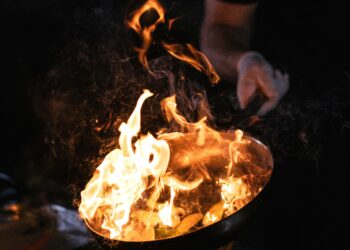Ecologist Jason Baldes’ life work is to restore herds of buffalo to public lands
By Carol Schmidt MONTANA STATE UNIVERSITY COMMUNICATIONS
Herds of American bison once roamed the vast river-veined plains and the sage-studded mountains of what is now the Wind River country of central Wyoming. They may do so again as a result of the work of Jason Baldes, a modern man dedicated to ancient ways.
As the tribal bison coordinator for the National Wildlife Federation, Baldes is recognized nationally for his efforts in an indigenous-led movement to return buffalo—the term Native Americans prefer—to Western reservations. His work is centered on his own Wind River Reservation, which is roughly the same size, and as ecologically diverse, as nearby Yellowstone National Park.
Over the last three years, the 40-year-old Montana State University graduate has led the building of the Eastern Shoshone Tribe’s small yet growing herd of genetically pure buffalo, which means their ancestors have not been interbred with cattle.
The work is intensely personal for Baldes, a member of a band of Shoshone Indians that call themselves gweechoon deka, the Buffalo Eaters. Even before the arrival of horses, the tribe followed the herds of large mammals who were the tribe’s life link, the center of their cultural, spiritual and material sustenance.
“The buffalo were our commissary—we used every part of the animal,” Baldes said. “If you restore the buffalo, you will heal the people.”
Baldes and his tribe have pieced together the Shoshone herd from several sources. The first 10 buffalo came from Iowa’s Neal Smith National Wildlife Refuge in 2016. Another 10 came a year later from the National Bison Range in Moiese, on Montana’s Flathead Reservation. There have been several calves born—five this year—an indication that the herd is thriving on the landscape that was once prime habitat for the migrating species.
In June, in collaboration with the National Wildlife Federation, Baldes organized a spiritual ceremony at the 300-acre Shoshone buffalo paddock near Pilot Butte Reservoir to welcome the latest arrivals: five bulls from the Fort Peck tribes’ reservation in northeastern Montana, the location of the tribal holding facility for animals captured after they migrate outside Yellowstone National Park.
Two days after the summer solstice, about 50 people joined Baldes to welcome the Fort Peck addition. The group lined a wind-kissed bluff about 20 feet above the pasture, so close they heard the animals’ grunting and swishing of tails in chest-deep bunchgrass.
It was a perfect morning, with one exception. The five new buffalo were stuck in Montana, their Fort Peck pasture so muddy with late spring rain and snow that the stock truck that would carry them could not load.
But because some participants had traveled far, Baldes went ahead with the welcome ceremony, negotiating what could have been an awkward situation as gracefully as he later hopped across rocks in his favorite trout stream.
“We are here today at a moment that has been years in the making,” Baldes said. “There were no buffalo on this ground for 130 years, and now, thanks to the Fort Peck tribes, we will receive our third group. And while those buffalo cannot be with us here today, it is important for us to talk to the buffalo that are on their way here, to welcome them here.”
Then Baldes explained, in words that he has repeated hundreds—maybe thousands—of times, that what the Shoshone are doing here is different. The hope is to manage the buffalo as a keystone wildlife species, as a cultural symbol, rather than as ranch or meat animals.
The story of
the rise and fall of the American buffalo, the country’s largest land-dwelling
animal, is as well-known as any tale of the Old West. The U.S. Fish
and Wildlife Service estimates that as many as 30 to 60 million bison roamed
North America before the time of Columbus. By the Westward Expansion, most
buffalo had been pressured into the West, where they were both the source of
food and basis for culture for the American Indian. But by
1878, U.S. Army Gen. Philip Sheridan encouraged the decimation of the
animal by market hunters to manage Indians by eliminating their food supply,
clearing the land for settlers.
The strategy worked. By 1902, there were 700 bison remaining in private
herds. The Yellowstone herd was then estimated at 23 animals, according to
the U.S. Fish and Wildlife Service. However, in one of the great
examples of American conservation, today the animal’s numbers are resurgent.
There are currently 20,000 plains bison in conservation populations managed as
wildlife in the U.S. (there are another half-million managed as meat
animals) and 5,000 of those are unfenced and disease-free, including about
4,500 in Yellowstone, according to the National Park Service. It is those
buffalo, descendants of the prehistoric wild buffalo herds that once roamed the
Wind River, that Baldes seeks as the source for the Shoshone herd.
There are other numbers and dates important to Baldes’ buffalo calculus. One is 1863, the date of the treaty with the U.S. government that created the Shoshone Reservation on 44 million acres in parts of what are now four states, the tribe’s historic hunting grounds. Five years later, the government reduced the size of the reservation to 0.05 percent of its original size and in 1878 put the Northern Arapaho, traditional enemies of the Shoshone, with them on what is now the Wind River Reservation.
According to the U.S. census, currently there are about 26,650 people living on the 2.2-million-acre reservation, including 15,000 non-Indians living on ceded lands. Still, Baldes figures there are thousands of acres of tribal lands on the reservation that could be used as buffalo habitat.
“A benchmark for conservation populations is a minimum of 1,000 animals in order to maintain genetic heterogeneity and variability,” Baldes has said of his goal. “We could accommodate thousands of buffalo here, no problem.”
Baldes said that once a sufficient population is reached, the tribe will conduct a lottery among members for a buffalo hunt. The meat will not be marketed, he said.
“We have the opportunity to manage them as wildlife, which is the greatest respect we can offer them,” he said. “The buffalo have helped me, personally. I know that as the buffalo heal and are restored to this land, our people will also be healed and restored. Because, we have a connection with them. We are people of the buffalo.”
This story has been shortened from its original version published in the fall 2019 edition of Montana State University’s Mountains and Minds magazine. Visit http://www.montana.edu/news/mountainsandminds/19345/the-descendents to read the full story.














